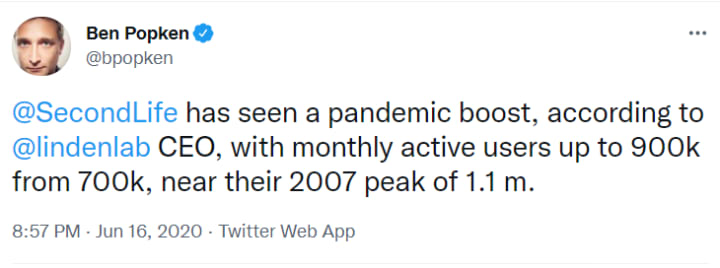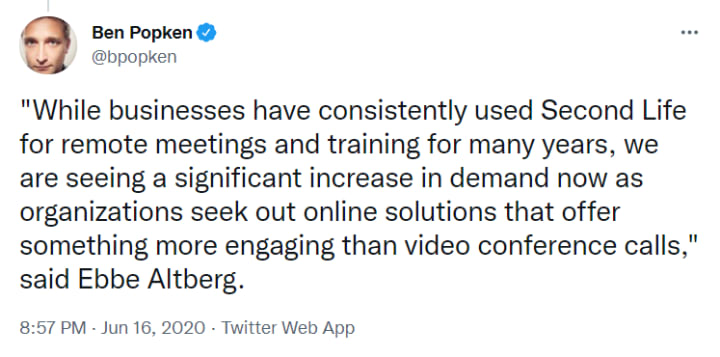Facebook did not invent the Metaverse
Some of us have been exploring it for decades

Just like the internet existed before social media, so did the metaverse.
Background
Since the recent Facebook announcement that they are embarking on the creation of a “metaverse”, some of the subsequent chatter has perpetuated the myth that the term is a new one. The truth is that Facebook is neither a pioneer of the metaverse nor of the social network. I only intend to address the former here, but may one day choose to dwell on the latter.
Metaverse: The Origin Story
Science fiction writer Neal Stephenson is widely credited with coining the term “the Metaverse” in the 1992 novel Snow Crash.
Stephenson’s Metaverse appears to its users as an urban environment, developed along a single hundred-meter-wide road, the Street, that runs the entire 65536 km (216 km) circumference of a featureless, black, perfectly spherical planet. Virtual real estate is available to be bought and buildings developed. Users of the Metaverse gain access to it through personal terminals that project a high-quality virtual reality display onto goggles worn by the user, or from low-quality public terminals in booths (with the penalty of presenting a grainy black-and-white appearance).
In the Beginning…
The internet is now a global territory, and part of its evolution has been the ability to exchange digital products or e-commerce. Advances in technology, growth in internet usage, and e-commerce, have contributed to the creation of virtual worlds.
Put simply, the metaverse is already here.
A Brief History of the Metaverse
The word Metaverse is a portmanteau of the prefix “meta” (meaning “beyond”) and the suffix “verse” (shorthand for “universe”).
Metaverses are persistent, collectively shared, three-dimensionally embodied online spaces populated by avatars. Metaverses, are already present on platforms such as VRChat or virtual worlds, e.g. Second Life. Frequently mistaken for MMORPGs, a virtual world is a computer-simulated environment or a platform with no set objective, therefore is not a game. To varying degrees, virtual world content, from terrain, buildings, grounds, and objects and wearables on sale, is often created by the residents of the world itself. Some virtual worlds have their own currency, some do not. Likewise, transport.
- In the late 1970s, text-based virtual worlds emerged in two varieties, multi-user dungeons, which involved the creation of fantastic realities that resembled Tolkien’s Lord of the Rings or the role-playing dice game Dungeons and Dragons.
- In 1986, Lucasfilm, partly inspired by the 1984 publication of William Gibson’s Neuromancer, introduced Habitat for the Commodore 64 and in 1989, the Fujitsu platform.
- In 1994, WebWorld offered a 2.5D world that provided users with open-ended building capability for the first time.
- In 1995, Worlds, Inc became the first publicly available virtual world with full three-dimensional graphics. Worlds, Inc. enabled users to socialise in 3D spaces.
- 1995 introduced Activeworlds, a virtual world based on Neil Stephenson’s 1992 novel Snow Crash. Activeworlds expected users to personalise and co-construct a full 3D virtual environment.
- In 1996, OnLive! Traveler became the first publicly available 3D virtual environment to include natively utilised spatial voice chat and movement of avatar lips via processing phonemes.
- Second Life launched on June 23, 2003, and its “residents” can explore the world (known as the grid), meet other residents, socialise, participate in both individual and group activities, build, create, shop, and trade virtual property and services with one another. By the end of 2017, the active Second Life user count was “between 800,000 and 900,000.”
- Avatar Reality’s Blue Mars, released in 2009, involved the most ambitious attempt to incorporate a much higher level of graphical realism into virtual worlds by using CryEngine 2, which was originally developed by Crytek for gaming applications, significantly raising the system requirements for client machines to a degree that was not cost-effective for Blue Mars’s target user base.
- Released in 2009, Solipsis was one of the first open-source virtual world systems relying on peer-to-peer architecture.
- Other open-source projects emerged, including Open Cobalt [Open Cobalt Project 2011], Open Wonderland [Open Wonderland Foundation 2011], and OpenSimulator [OpenSimulator Project 2011].
Ways of the world: Uses for the virtual environment
When virtual worlds went through a surge in popularity in the early 2000s, some organisations took advantage of the virtual environment. The IBM Academy of Technology held major events in Second Life including a Virtual World Conference and a general meeting for the Academy. IBM and Linden Lab estimated that the event saved $320,000 in travel and venue expenses and provided productivity gains since the participants could go right back to work when the conference concluded. It is not difficult to see how this could be used in a similar way, in a hybrid or even wholly remote, working environment, in 2021/22.
Virtual worlds are also being used in the creation of involved play/rituals, storytelling sessions, and fantasy role play.
Why did usage shift from mainstream to niche?
Many commentators claim that the learning curve is too high for those new to a virtual environment. The system requirements to run virtual worlds coupled with the requirement for specific software aka as a “client” or “viewer” to enter the world require a level of commitment. In-browser and app versions have not evolved sufficiently to make them anything more than a temporary solution for accessing virtual worlds in most cases.
There was also the bad press
Unlike social media platforms where we mostly find our friends from real life, one of the advantages of a virtual environment is the ability to create an alternate identity (in fact, multiple identities) with an endless ability to modify the appearance of the avatar (Boellstorff 2008: 128–34). This, in itself, did not create the positive media coverage you would hope to see.
There were stories in the news of people having online affairs, and of people exploring their kinks and fantasies, in a virtual environment. With older people preying on the too-young, and age-play (where the avatars are younger than the person behind them), there were safeguarding issues that needed to be resolved. In the case of Second Life, there was also porn/adult content, gambling and banking to be worked out, along with the ongoing issue of intellectual property rights and processes for reporting infringement. Issues of governance were addressed but not before the bad press, and not without a significant amount of effort and legal wrangling by the creators of Second Life, Linden Lab. Being a metaverse pioneer does not come without its costs.
There are positive news stories of users of virtual worlds experiencing improved body image, improved mental health, accessibility for people with disabilities, but these do not make good clickbait headlines. People have even found love, without having a scandalous affair.
Pandemic: Increasing interest in virtual spaces


In Metaverse Roadmap: Pathways to the 3D Web. A Cross-Industry Public Foresight Project, Smart et al (2008), explain that the complexity of the Metaverse results in uncertainty about how and when its features will manifest in society. They highlighted the following themes.
Recurring themes such as security and crime, transparency, information access and equity, privacy, liberty, and control reflect ancient competing interests on what is simply the latest stage of technical capabilities. Social conflicts will shape the path of Metaverse development in uncertain and divergent ways, culture by culture, even while the global advance of these technologies appears to have a number of predictable and universal aspects.
In Conclusion
The renewed interest in all-things-metaverse as a result of both the pandemic and the Facebook announcement should be seen as an opportunity to those already working in the metaverse space to build upon their existing efforts and capitalise on the renewed enthusiasm.
For those inhabiting and socialising in a virtual environment, this metaverse revival is an opportunity to enjoy the increased traffic and potential for investment in infrastructure because even when the tourists leave, there will always be some that like it so much they choose to stay.
Avatars may be made of pixels, but it is people that are pulling the strings, not corporations.
While Facebook did not invent the metaverse, a quick look at domain name availability has shown an increased interest in branding the metaverse to monetise the populist nature of social media, and that spotlight will shine brightly enough to showcase other metaverse-makers, too.
Photography
With the exception of Twitter screenshots, all photographs are taken in Second Life by JoJoBonetto using the avatar Josephina Bonetto.
References
Ayiter, E. (2019) “Spatial Poetics, Place, Non-Place and Storyworlds: Intimate Spaces for Metaverse Avatars,” Technoetic Arts, 17(1).
John David N. Dionisio, William G. Burns III, and Richard Gilbert. 2013. 3D Virtual worlds and the metaverse: Current status and future possibilities. ACM Comput. Surv. 45, 3, Article 34 (June 2013).
Kasnitz, D. (2010) “Coming of Age in Second Life: An Anthropologist Explores the Virtually Human. Tom Boellstorff. Princeton University Press. 2008. Ix 316pp,” Ethos, 38(1)
Lawrence Lessig, Code and Other Laws of Cyberspace, New York: Basic Books, 1999.
Ludlow, Peter, and Mark Wallace. The Second Life Herald : The Virtual Tabloid That Witnessed the Dawn of the Metaverse, MIT Press, 2007.
Owens, D. et al. (2011) “An Empirical Investigation of Virtual World Projects and Metaverse Technology Capabilities,” ACM SIGMIS Database: the DATABASE for Advances in Information Systems, 42(1).
Smart, John, Cascio Jamais, and Jerry Paffendorf. 2008. Metaverse Roadmap: Pathways to the 3D Web. A Cross-Industry Public Foresight Project. Available online (accessed on 28 November 2021).
About the Creator
Enjoyed the story? Support the Creator.
Subscribe for free to receive all their stories in your feed. You could also pledge your support or give them a one-off tip, letting them know you appreciate their work.






Comments
There are no comments for this story
Be the first to respond and start the conversation.